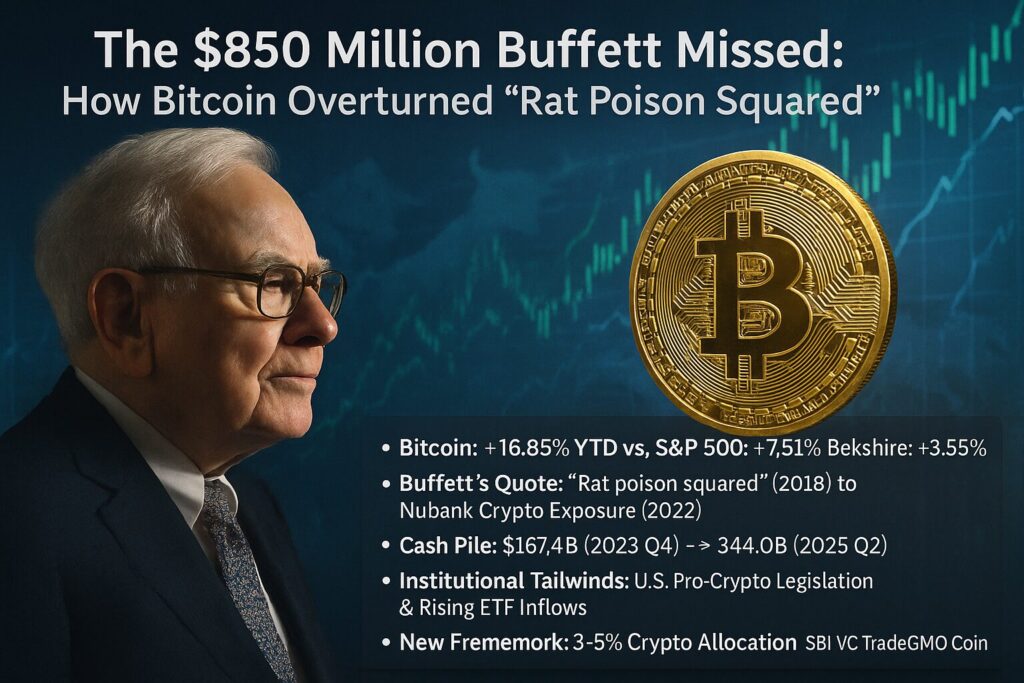
Key Takeaways:
- Buffett’s historic opportunity cost: By avoiding Bitcoin, Berkshire Hathaway missed roughly $850 million in gains so far in 2025.
- Bitcoin’s outperformance: +16.85% year-to-date vs. +7.51% for the S&P 500 and +3.55% for Berkshire Hathaway stock.
- Buffett’s critique timeline: From calling Bitcoin “rat poison squared” in 2018 to indirect crypto exposure via Nubank in 2022.
- Cash hoarding trend: Berkshire’s cash pile grew from $167.4 billion (2023 Q4) to $344.0 billion (2025 Q2), signaling a scarcity of traditional opportunities.
- Institutional and regulatory tailwinds: Renewed U.S. pro-crypto legislation, rising ETF inflows, and corporate adoption have bolstered Bitcoin’s legitimacy.
- New-era investment framework: Combining value-oriented stocks with a 3–5% crypto allocation may reduce the risk of missing paradigm-shifting gains.
- Recommended Japanese crypto venues: Reviews of BitTrade, bitbank, Coincheck, SBI VC Trade, and GMO Coin for secure access to major digital assets.
1. A Historic Opportunity Cost for Value Investing
2025 has been a landmark year for Bitcoin. The world’s largest cryptocurrency has maintained trading levels above $114,000, up roughly 16.85% since January 1, 2025, eclipsing the S&P 500’s 7.51% advance and Berkshire Hathaway’s 3.55% gain through early August 2025. Meanwhile, Berkshire Hathaway’s second-quarter earnings report showed net income of $12.3 billion, but a 59% year-over-year drop—highlighting that, despite strong results, Buffett’s firm significantly underperformed Bitcoin this year.
In dollar terms, had Berkshire allocated just 5% of its $344.0 billion cash reserve into Bitcoin at the start of 2025, it would now hold an unrealized profit of approximately $850 million, per basic simulation. This figure starkly illustrates the magnitude of gains foregone by adhering strictly to traditional value investments.
[Insert Figure 1: 2025 YTD Performance Comparison chart here]
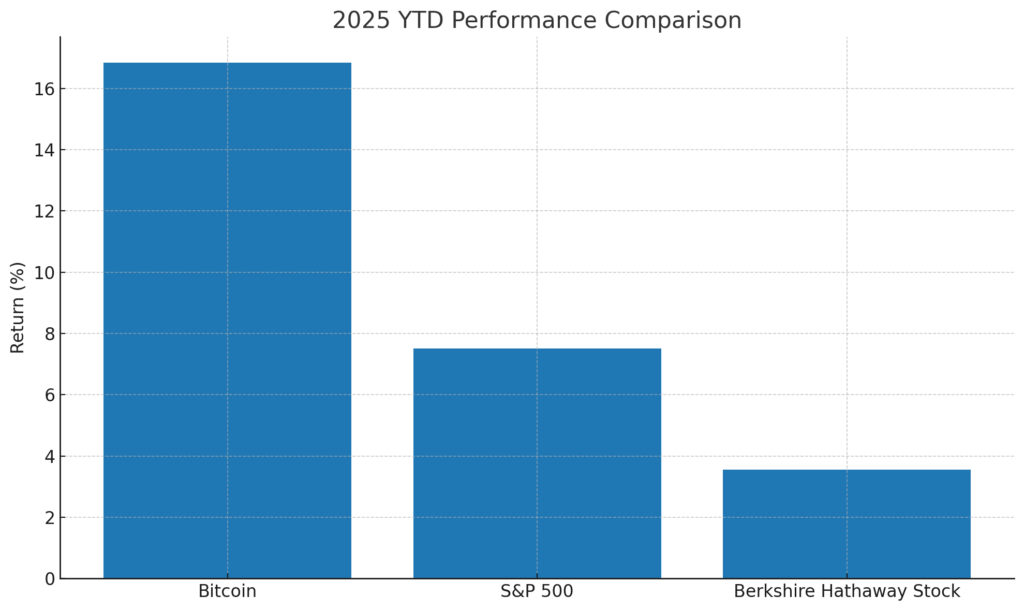
2. Buffett’s “Rat Poison Squared”: A Misjudgment in Hindsight
Warren Buffett’s skepticism toward Bitcoin is legendary. At the 2018 shareholders’ meeting, he dismissed Bitcoin as “rat poison squared,” predicting it would end badly. At that time, BTC traded around $10,000. A few months later in May 2018, he reiterated that Bitcoin “produces nothing,” while prices slid to about $8,000.
By 2022, Buffett indirectly dipped his toes into crypto via Berkshire’s investment in Nubank—a “digital bank” with ties to the crypto industry—when BTC hovered between $30,000 and $60,000. Yet it wasn’t until August 2025 that Bitcoin blasted past $114,000, more than a 1,000% increase from his initial critique.
This timeline underscores a critical lesson: even a paragone of value investing can misread transformative technologies. Buffett’s famed principle—invest only in productive assets—failed to capture Bitcoin’s network-driven value proposition.
3. Cash Hoarding vs. Crypto Growth: Missed Windows of Opportunity
Buffett’s conservative approach emphasizes liquidity. Berkshire Hathaway’s cash hoard jumped from $167.4 billion at the end of 2023 to $189.0 billion in Q1 2024, $267.5 billion in Q4 2024, and $344.0 billion in Q2 2025. This 11-quarter streak of net equity sales suggests Buffett saw too few traditional opportunities.
[Insert Figure 2: Berkshire Hathaway Cash Holdings Over Time chart here]
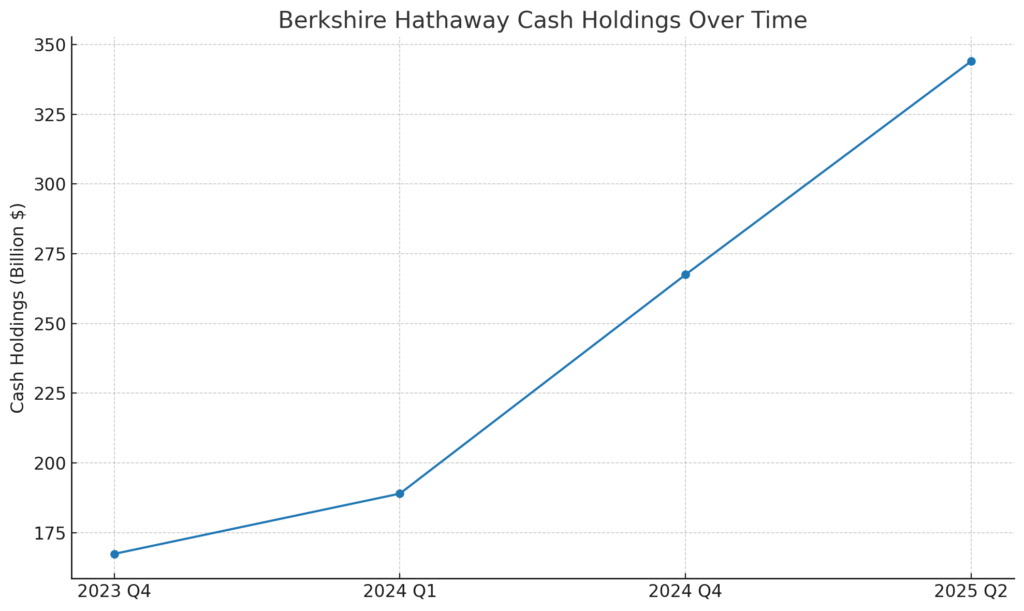
While Buffett waited for undervalued names, Bitcoin’s rise capitalized on network effects and global demand. Allocating even a small portion of idle cash into crypto this year would have yielded meaningful returns. The cost of inaction—measured in hundreds of millions—raises questions about portfolio rigidity during paradigm shifts.
4. The Evolving Institutional Landscape and Bitcoin’s Role
Recent months have seen seismic regulatory changes. Under the Trump administration’s new crypto plan, longstanding SEC lawsuits against major exchanges were dropped, stablecoin frameworks eased, and tokenized equity trials began—transforming crypto from fringe to mainstream. ETF inflows and corporate treasuries piling into Bitcoin have further cemented its status as a digital asset akin to gold.
Academics confirm the shift: correlations between Bitcoin and U.S. equities have intensified, with rolling-window studies showing a correlation coefficient as high as 0.87 in 2024, underscoring Bitcoin’s integration into institutional portfolios. This expanding legitimacy reduces Bitcoin’s volatility premium and bolsters its case as a diversify-plus-growth component in modern asset allocation.
5. Bridging Traditional and Digital Assets: A New Investment Paradigm
No single framework fits every investor, but lessons from Buffett’s miss point to a blended approach:
- Safe-Focused Strategy
- 70% Equities25% Bonds3% Cryptocurrencies2% Cash
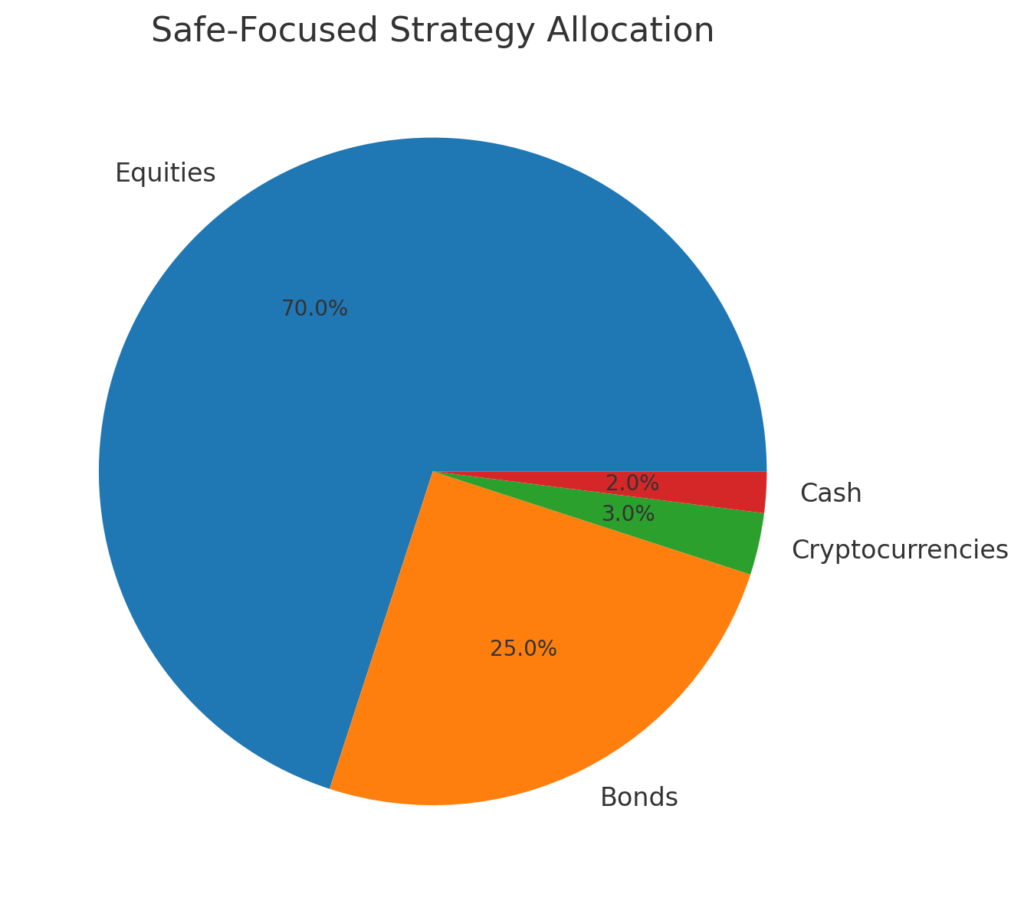
- Balanced Strategy
- 60% Equities20% Bonds10% Cryptocurrencies10% Other Assets (e.g., real estate, commodities)
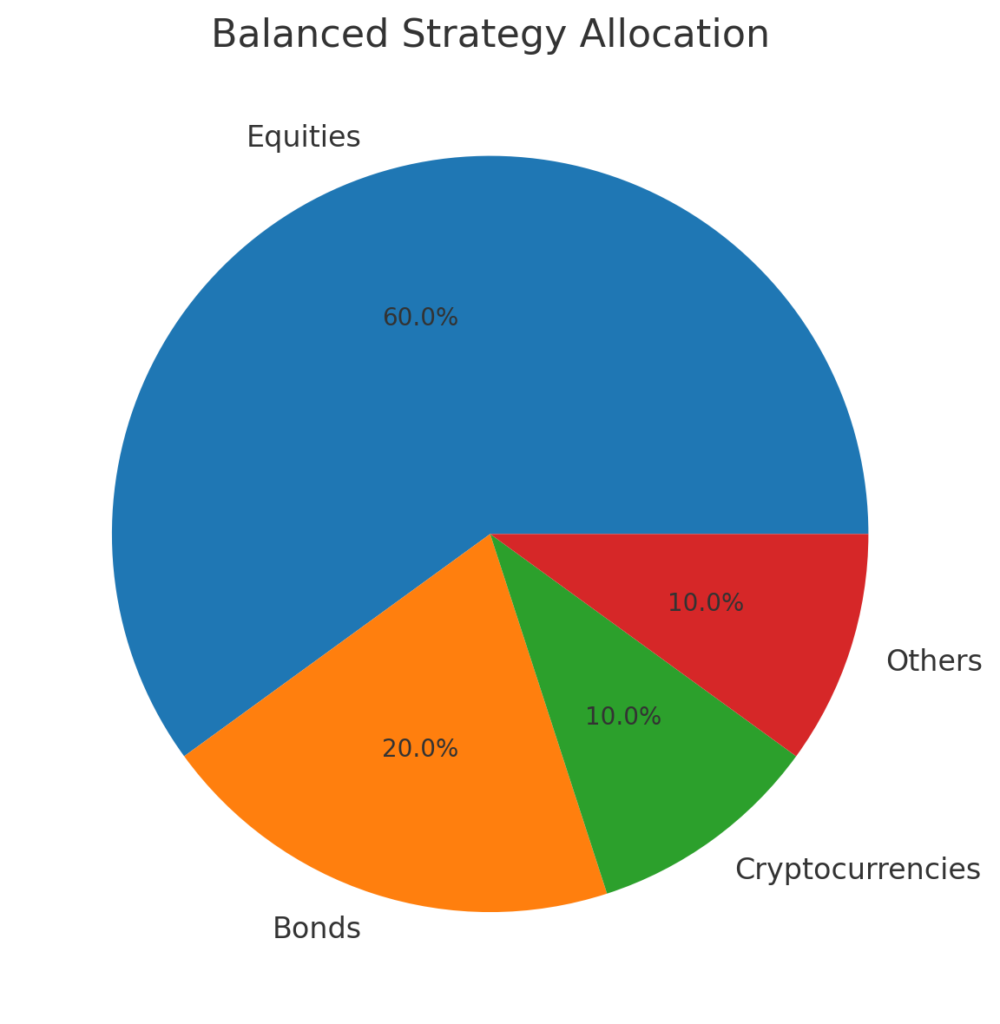
- Growth-Focused Strategy
- 50% Growth Stocks20% Cryptocurrencies15% Bonds15% Other High-Beta Assets
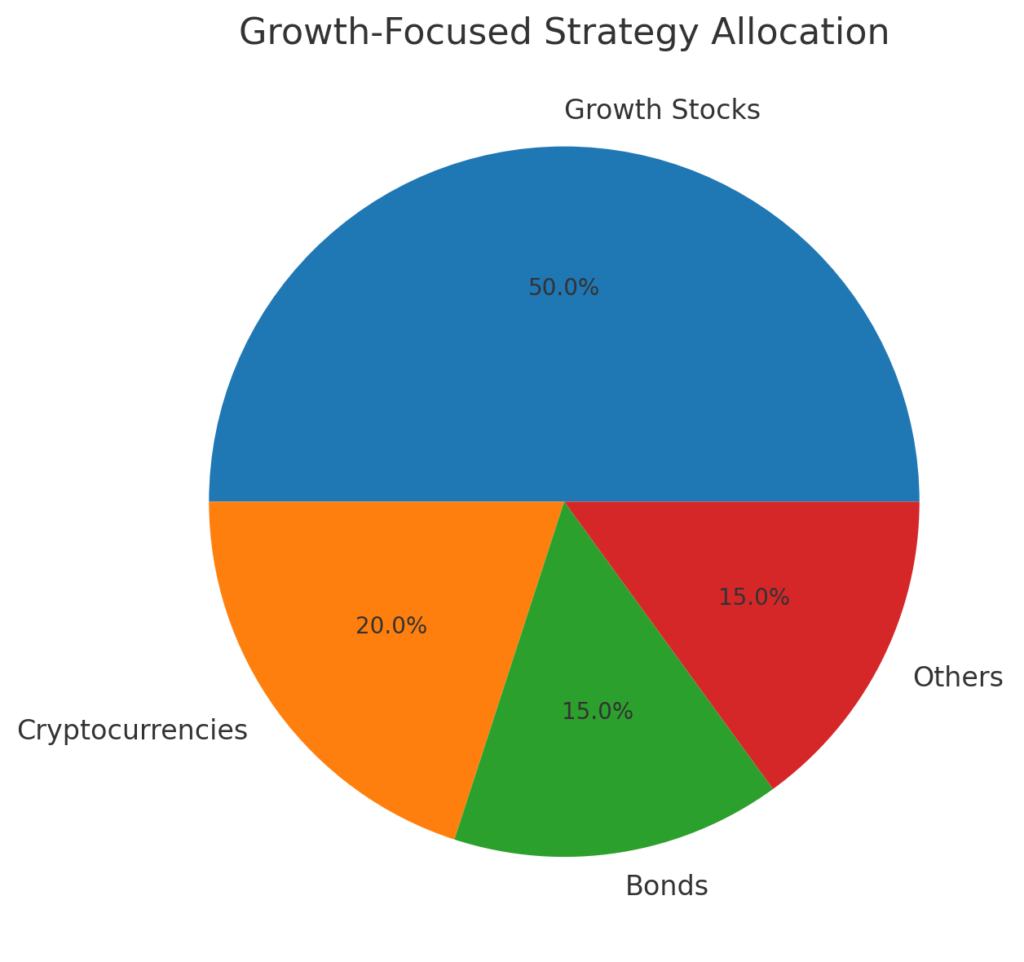
Allocating 3–10% to crypto can materially improve returns without exposing investors to full market swings. The ideal mix depends on risk tolerance and time horizon, but a token allocation empowers portfolios to capture digital-asset-driven alpha.
6. Recommended Crypto Exchanges for Japanese Investors
For readers based in Japan seeking reliable platforms:
- BitTrade
Established exchange with robust security and a wide range of altcoins. - bitbank
High liquidity for BTC, ETH, and major tokens; advanced charting tools. - Coincheck
User-friendly interface, fiat on-ramps, and staking services. - SBI VC Trade
Backed by SBI Group, strong regulatory compliance, and JPY pairs. - GMO Coin
Integrated with Japanese banking, leveraged trading, and mining pool access.
Each offers JPY/USD markets; fees and KYC processes vary, so compare trading volumes, withdrawal limits, and insurance coverage before choosing.
Conclusion: Lessons for the Modern Investor
Warren Buffett’s steadfast adherence to value investing safeguards capital—but it also risks sidelining emergent asset classes. In 2025, Bitcoin’s 16.85% rally illustrates how a small allocation to blockchain-based assets could have rescued hundreds of millions in unrealized gains for Berkshire Hathaway.
The fusion of institutional adoption, favorable regulation, and network effects marks a new phase: digital assets are no longer peripheral but integral to diversified portfolios. Whether you favor a conservative, balanced, or growth-oriented stance, dedicating 3–10% to cryptocurrencies positions you to seize opportunities Buffett’s framework once dismissed.
As markets evolve, so must our strategies. Embrace technological shocks with disciplined flexibility—this balance may well define your success in the next crypto-enabled era.

